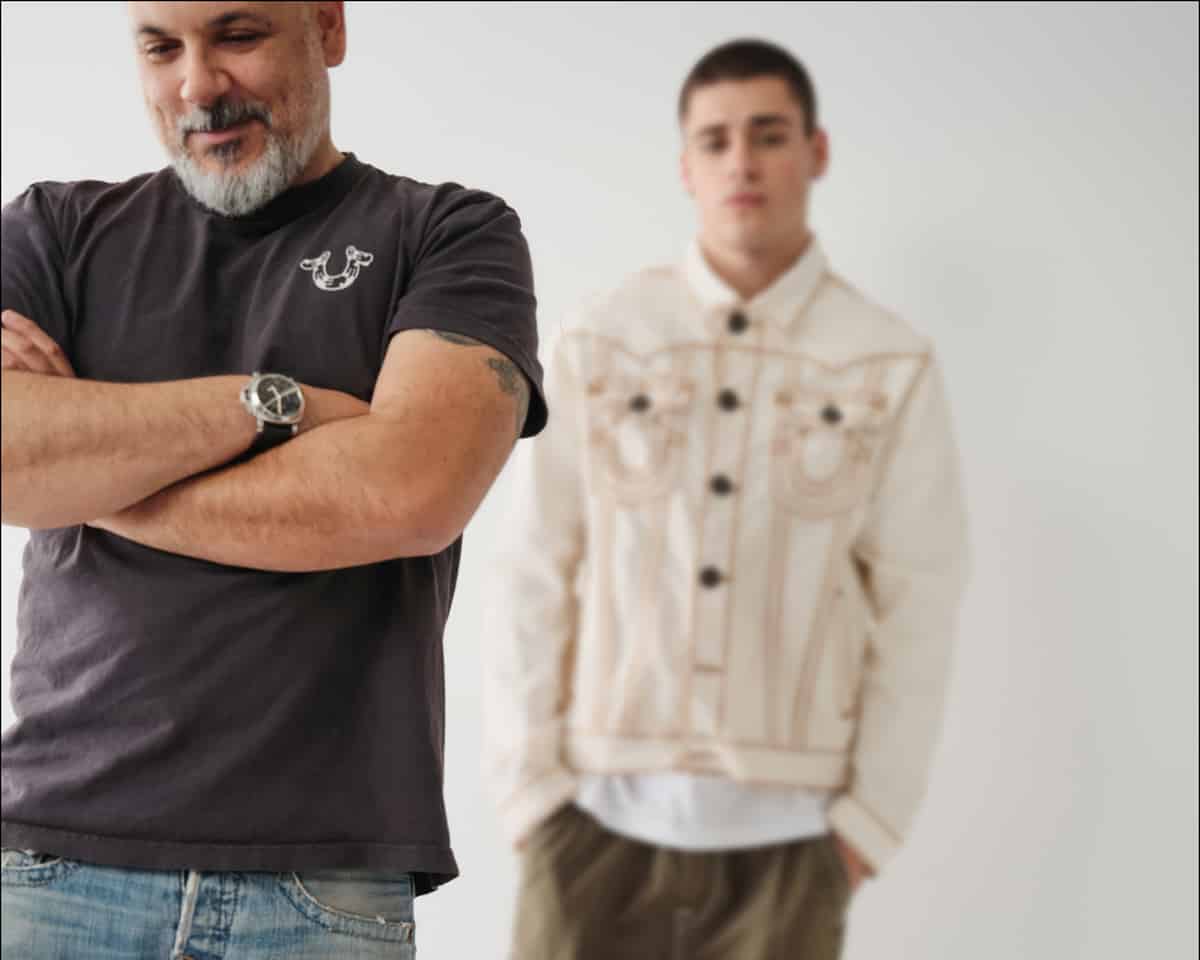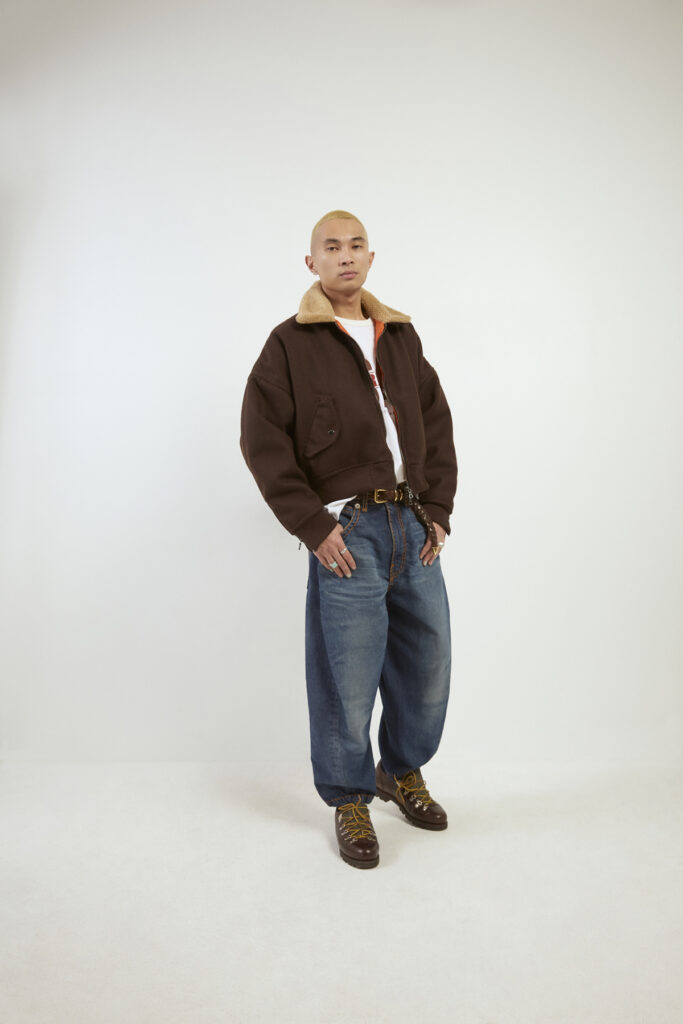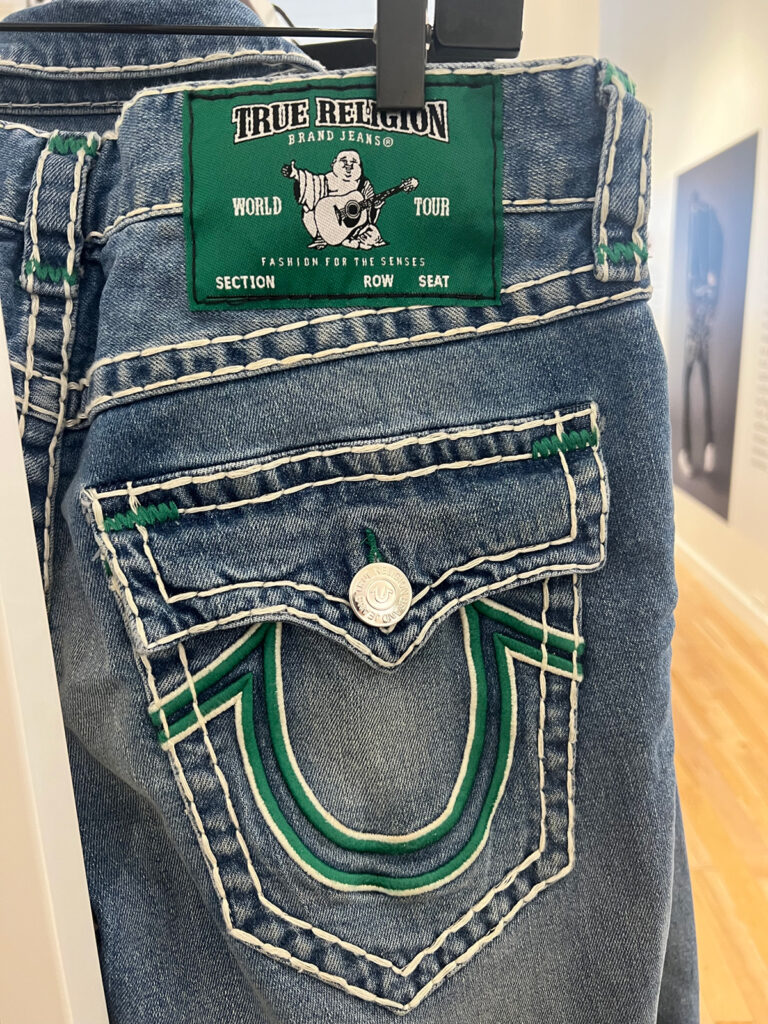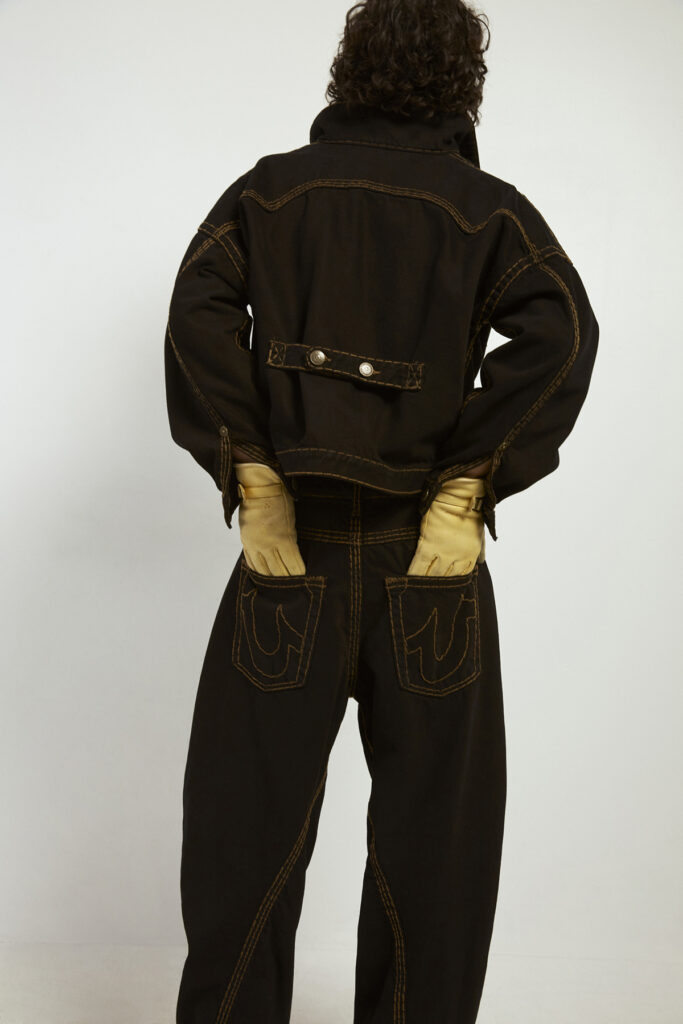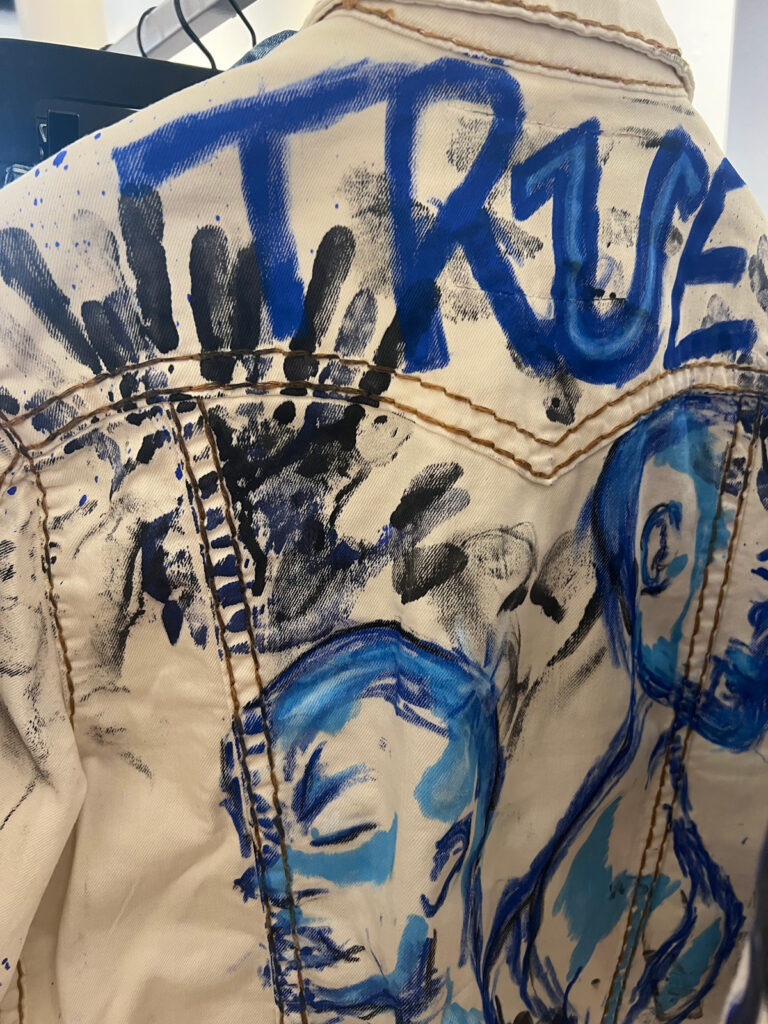FINDING TRUE RELIGION: A CONVERSATION WITH CREATIVE DIRECTOR ZIHAAD WELLS

There’s so much “Y2K” influence in fashion right now that denim brand True Religion has found itself in the unique position of appealing to both a young customer — who is discovering it for the first time — and an older customer, who has a certain nostalgia for the brand, but may also be buying it for the first time because the price point is more approachable. After True Religion’s press preview earlier this year, we had a chance to talk to the brand’s Creative Director Zihaad “Zee” Wells, who brings a unique perspective to the brand: He was its first design director in 2006, holding the title until 2017.
True Religion was founded in 2002 by Kym Gold and Jeffrey Lubell. Michael Buckley, who had done stints at Ben Sherman, Robert Graham, and Differential Brands, was president of True Religion Apparel from 2006 to 2010 and returned as its CEO in 2019. He was instrumental in bringing Wells back to the fold.
The brand also recently announced expansion into China with partner Aurorae Group, owner of EVISU Group. Plans are underway to open a mix of 65 freestanding stores and shop-in-shops by 2026, growing to a total of 108 by 2028. The Chinese market is expected to represent 10% of True Religion’s global brand volume by 2026. The partnership also expands True Religion’s ecommerce presence in the region. Tmall.com, JD.com, Douyin.com, and Dewu.com, among others, will soon offer True Religion merchandise. True Religion’s own direct-to-consumer ecommerce business will continue to focus on key markets, specifically growing North America.
The brand’s preview teased some iconic pieces for Fall 2023, including those from collaborations with Sebastian Ami, a Los Angeles based streetwear label, and leather jacket designer Jeff Hamilton, famous for his over-the-top leather and varsity jacket designs and licensed product with professional sports leagues. Also shown were rope-stitched pieces that, as it turns out, sold out almost immediately.
“We went through a moment where the brand tried to be everybody other than who they were,” says Wells. “Michael asked me to come back in 2019, and the whole point was to tap into the DNA of the brand. My mandate was very clear: What’s unique about us? What are we good at? What do people love about our brand? How do we get more of that, and less of the things that weren’t successful? What do we do well, and who do we do it for? We spent the last few years really tapping into that, focusing on the thing that makes us unique, and the experience we provide as a brand, let alone just the product we make. Now, when I look at the marketplace, I don’t think in terms of competitors, I think in terms of who do I want to sit next to? I know no one’s going to wear True Religion head to toe — and neither should they — but what brands are they going to wear me with. If I tap into what we were we’re really good at that puts us in a better position for the next 20 years.
“At press preview we were able to show the next generation of True Religion. It’s steeped in detail and in the way we construct denim. There’s an idea of amplification or exaggeration of detail that has been part of culture for the last like 200 years. We had some nods to the past, like our original jeans and our original washes, but also the Sebastien collection, which was definitely a nod to the future: The silhouettes were different. The weights were different, the denim was different, but it was all heavily constructed. It had Western detailing.
“This brand is rooted in the West. Jeff, our founder, was a hippie at heart and was really into what California and the West represented at the time, which was a feeling of optimism, and I think that’s evidenced in a pair of jeans. I truly just makes you smile. You don’t necessarily rcognize a pair of True Religion jeans from seeing the arch embroidery on the back pocket. You can recognize the construction from across the street. We built icons. I would like to be seen at some point in the same way that people view the [Nike] swoosh.
“We recently acquired 1000 pairs of vintage shirts and jeans for our archive. When we work with collaborators, we go through this archive and show a mix of some things that we made and things that never made it. When we take people to see it, you’ll hear ‘Oh, I remember wearing this in high school!’ and then people have all these memories of True Religion, and maybe they wanted it, but their parents couldn’t afford it or something, and you realize the impact this brand has had on so many people, whether it’s culturally through seeing emerging artists who then became established artists wearing it, whether its 2 Chainz or Chief Keef or some celebrity. For a lot of people this was their entry into branded luxury. True Religion was adopted by the streets and in that sense. It was probably the first expensive pair of jeans or first expensive piece of clothing that most people bought back then.
“There’s something about this brand that just makes you feel something. It’s animated, it’s amplified, it’s unapologetic. It’s not trying to help you blend in, it’s allowing you to stand out.”
MR: So where does the brand land at retail now versus where you were back then? [Editor’s note: at press time, the True Religion website is retailing jeans for just under $100 up to $160. On a major department store’s website, they are up to $239, which Wells addresses, below.]
Wells: It depends. Some of the collaborations, like Sebastian or Supreme [most recently from Fall 2022] sits near where we used to at around mid $200 to $300, even up to $400 for the Supreme. When we do something special, that feels unique, there’s something to be said for the value in paying a little bit more for something that is special, and a limited edition. As a brand, we understood that our demographic starts a lot younger: Kids who are 15, in high school, who love True Religion to death. As a result, we need to make sure we’re accessible. We want them to buy it. We want them to wear True Religion. We’ve been fortunate enough that the last 20 years established us with a premium perception. The T-shirts and the jeans are at a more accessible price point, but $100 is still a lot of money for a lot of kids. We’re more accessible than when we were, but we’re not cheap. Our goal is still to be able to offer something that is unique and special.
MR: Where are you retailing right now? Where is this kid finding you?
Wells: We have our own retail, which is predominately based in outlet malls. They aren’t outlet stores, but they just happen to be in outlet locations. It’s still the full price collection. Then we sit in some specialty stores. In Europe or outside of the U.S., True Religion sits at a much higher part of the market: Selfridges, Harvey Nicks, Browns, and Farfetch. In the East we sit in much higher end stores, next to luxury brands. The market’s just different. The American market is much more promotionally driven as a whole, whereas in Europe, they still buy into seasons. They actually look at pre-fall collections and pre-spring collections, and dress for occasions. They’re willing to pay for a brand and not look for promotion. The fortunate thing for us as a brand is we’ve been able to segment ourselves in such a way that we can be many things to many people because we’re cross-generational and we sit in different places. That’s a luxury that we don’t take for granted, and we make sure that the product that sits in specialty isn’t the same as the product that sits at our DTC doors or on our site…especially if they’re paying more for it.
MR: What do you feel about what’s happening with denim from a style standpoint? Very clean and plain? Ripped and shredded?
Wells: It depends. It can be all those things. There were moments when it was all about clean or all about destroyed but now, I think it depends on who the brand is what the consumer is doing with it, how they’re customizing it, how it shows up. We tend to make sure that we have a range, from dark to light, to appearl to people’s moods, and what they want. The most important thing for us is construction. We know that our stitched product is something unique. It’s something that people will search for. We do drops throughout the year, so we dropped a limited run of the rope stitch from our archives. That hadn’t been out for 20 years, and without collaboration or support, at $259 retail, it sold out. There were a couple of jackets left. Back in 2021 we kept getting comments on Instagram asking us to bring back the Ricky Red Stitch Jean. We brought it back with 600 units. We sold out in 24 hours. We were joking about it, calling it the ‘McRib Strategy: It’s back for a limited period of time, get it while you can,’ building the whole thing on a sense of urgency. It comes down to this:It’s like the way Nike drops Jordans. There’s a drop on a Tuesday. It’s sold out by Wednesday. Who knows when it’ll be back again. There’s a couple more coming later on this year. It keeps our audience engaged. It’s something special that you can’t get anywhere else. And in a world of creating mass product, I want to make sure there’s still an element of something that’s really special.
I rarely look at our competitors: I look at the experience. It’s not as much about how a piece of clothing makes you look: it’s how it makes you feel. There’s something about this brand that just makes you feel something. It’s animated, it’s amplified, it’s unapologetic. It’s not trying to help you blend in, it’s allowing you to stand out.


